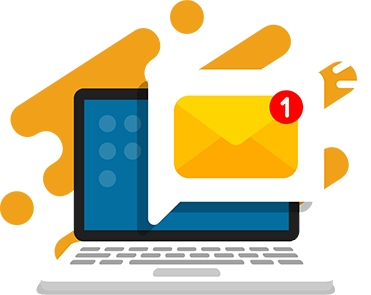Kids with an eye to their future know that learning to code is important, but figuring out which language to learn can be an intimidating task. With a balance of being both easy to learn and widely used in the real world, we suggest learning Python for kids.
Some languages are easier to learn, while others have a wider application. But Python sits right in the sweet spot. That’s why it’s the programming language kids start with in our middle school and high school coding programs.
Python coding is a skill that will benefit kids now and well into the future. This guide gives kids an introduction to Python language and kickstarts your child’s learning with Python video lessons.
What is Python?
Python is a computer programming language created by Guido van Rossum in 1991.
Python emphasizes readability and simplicity, allowing developers to express concepts in fewer lines of code compared to languages like C++ or Java.
It’s easy to read and has some similarities to the English language with influence from mathematics.
Python is used in:
- Web Development
- Game Development
- Software Development
- Data Science and Machine Learning
- Automation and Scripting
- Artificial Intelligence (AI)
- Natural Language Processing (NLP)
- Scientific Computing
- Financial Technology
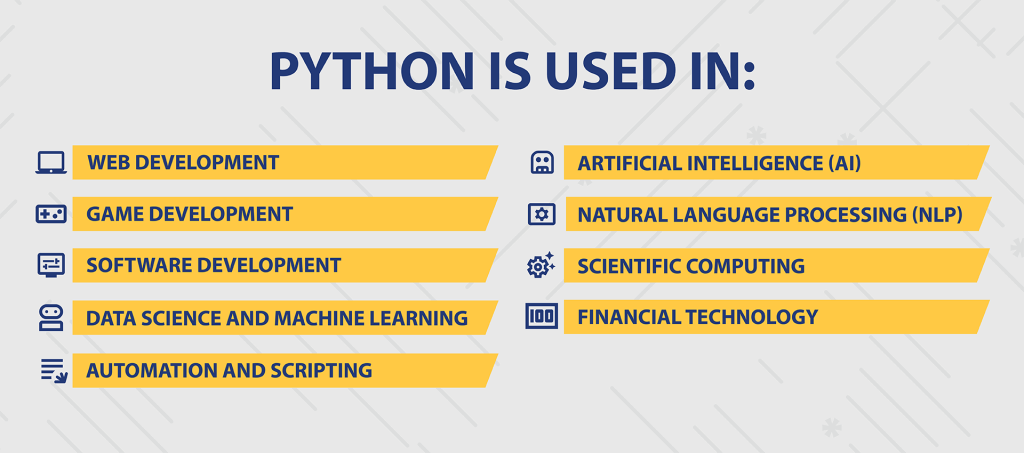
Python is a preferred choice for kids and teens who want to learn coding. We dedicate most of our core coding tracks to learning Python because of the many benefits it offers.
Why Should Kids Learn Python?
Python is Beginner Friendly.
Python is an ideal starting point for beginners and kids.
It can be overwhelming for kids the first time they’re reading and writing code. We recommend Python for our students because it reads a lot like English. Even for kids without programming experience, it’s easy to understand.
Python uses new lines to complete a command instead of semicolons or parentheses in other languages. It also relies on indentation, using whitespace, to define scope whereas other programming languages often use curly-brackets for this purpose.
With other languages, the strange combinations of words and punctuation can seem impossible to decipher.
Learning the basics of Python isn’t nearly as difficult. As a result, kids feel less intimidated and can focus on concepts instead of syntax.
Kids Won’t Outgrow Python.
A few programming languages designed for beginners are purely graphical. These are called “block” languages.
Scratch is an example of a block programming language. Although Scratch is good for elementary school children, it’s easy to outgrow because it’s not used in major applications.
That’s not the case with Python. Python can be used to build anything from simple websites with just a few users to professional and enterprise applications with millions of users. It uses real coding syntax and foundational coding skills that kids can also apply when learning other languages.
Python language has an extensive library, ecosystem, and community. It’s a popular and relevant language that will grow with your child as their skills improve.
Python Is Applicable In the Real World.
Python is used across various fields and industries, many that we interact with everyday.
For example, Python powers the world’s second-largest search engine: YouTube. It’s also used in many of the world’s most popular websites like Google, Yahoo, and Instagram.
Python is often used in:
- web development
- data science
- software development
- artificial intelligence
- machine learning
- game development
- scientific research
Python has its influence in technology, finance, education and many other industries too. Software engineers build neural networks and other forms of artificial intelligence with this versatile language. Scientists use Python to work with large data sets.
Because of its wide range of applications, kids who learn Python will easily be able to use this skill in the real world.
Tips for Kids to Successfully Learn Python
Gamification Encourages Kids to Learn
Motivation is a key component of successful learning. Students can get bored and abandon a subject before they become proficient without the proper incentives. This is why gamification, or the use of game design elements, is now so popular in online and live classrooms.
Score-keeping, competition, and rewards are great ideas for holding kids’ attention and teaching them everything from algebra to programming in Python. Studies have shown that gamification can increase classroom engagement and cognitive development.
We use gamification in our coding classes by using points, badges, and competitions to motivate student learning. As a result, overall student grades and passing rates have improved.
Use Project-Based Learning for Engagement
Many of the biggest names in technology started coding to build simple programs for themselves, friends, or family.
Mark Zuckerberg, Bill Gates, and Steve Jobs are just a few examples. They got excited about coding by building small but fun personal projects. Dreaming up a game or website, and then figuring out how to build it might be the most effective way to master a programming language like Python.
It’s often necessary to learn the basics before beginning, but it’s possible to be proficient enough to build impressive programs in just a few weeks.
The key is to ease kids into learning Python by working with small chunks of information at a time. If the information is organized into a highly visual format, that’s even better.
The best coding books for kids are divided into short segments with plenty of pictures and small bits of text. Some coding classes offer short lessons that kids can complete in just a few minutes. These are perfect ways to introduce the Python programming language to kids.
Practice is a Must.
Skills stick when we learn them over time, when there is spaced repetition, and when we practice them over and over.
Python programming is just like any other skill, it requires frequent practice and takes time to learn.
Kids who regularly use their Python skills to build projects and solve problems will retain their knowledge. Unless you’re just looking for a one-off class, you want your child to have deep, meaningful learning.
Those who don’t practice regularly are likely to forget most of what they’ve learned in a very short period of time. Our Python classes for kids are year-round so kids can practice every week and build a robust portfolio of projects and skills over time.
Practice is crucial, so make sure your child has regular opportunities to use Python.
Introduce Kids to Coding in Python
Now let’s dive into learning Python with these 10 introductory concepts. Learning these will give you an overview of the Python language and syntax.
Once you’re familiar with the concepts and have practiced with the activities, you can complete your first Python project.
1. Introduction to Python and Coding
Computers are machines that process data. While they are powerful, they don’t do anything until they’re told to. Computers run many programs, like your word processor or browser. A program is a set of instructions we give the computer to tell them what to do.
A program is similar to a recipe, it provides step-by-step instructions to perform a task. Programmers are the ones who write these instructions in code. The computer then reads the code and performs each instruction to complete a task.
Basically, programmers write the code and computers read and execute the code. It’s that simple!
In the middle school and high school coding programs, new students start with Python. We chose Python because it’s both easy to learn and very powerful.
Activity – Which of these uses code?
2. Data Types
Data is information stored in a computer or in code. It’s a collection of numbers, letters, and symbols.
A data type is a classification of data that tells the computer how to use it. The data type determines what values data can have and the operations that can be performed on this data.
For example, if a number has an integer data type, it can have operations performed on it such as addition and division. Most programming languages support basic data types such as numbers, characters, and booleans.
In Python there are standard data types kids should be familiar with:
- Integer: 14, -3, 0
- Float: 20.5, 338.78, -0.33
- String: “CodeWizardsHQ”
- Boolean: True or False
- List: [“apple”, “banana”, “cherry”]
- Tuple: (“Roblox”, “Fortnite”, “Minecraft”)
- Dictionary: {“name”:“John”, “age”:36}
Integer: An integer is a whole number that can be positive, negative, or zero. The year, 2024, or days in a week, 7, would both represent integers.
- Example: 14, -3, 0
Float: Floats are decimal values or fractional numbers. A temperature like 98.6 degrees would be a float.
- Example: 20.5, 338.78, -0.33
String: A series of letters, numbers, or symbols enclosed in either single quotes (”) or double quotes (“”). As long as it’s in quotes, it’s a string.
- Example: “CodeWizardsHQ”
Boolean: Booleans represents one of two values, either True or False. They’re use to determine if an expression is true or false. Like a light switch, if it’s on it’s true and it’s it’s off it’s false. Booleans are written with a capital letter and do not have quotes around them.
- Example: True, False
List: A list is an ordered, changeable (or mutable) collection of data written with brackets [ ]. Think of a grocery list with a group of related items, like fruits.
- Example: [“apple”, “banana”, “cherry”]
Tuple: Tuples are similar to lists except that they’re an ordered, immutable collection of data meaning they can’t be changed once they’re created. They are written with parenthesis ( ).
- Example: (“roblox”, “fortnite”, “minecraft”)
Dictionary: These are mutable (or changeable) data structures that store elements in key-value pairs. The key “name”, might be paired with a value like “John”. The dictionary is written with curly braces { }.
- Example: {“name” : “John”, “age” : 36}
The full list of built-in Python data types includes:
- Text Type: str
- Numeric Types: int, float, complex
- Sequence Types: list, tuple, range
- Mapping Type: dict
- Set Types: set, frozenset
- Boolean Type: bool
- Binary Types: bytes, bytearray, memoryview
To see the data type of an object, use the type() method in Python.
Activity – Which data types are these?
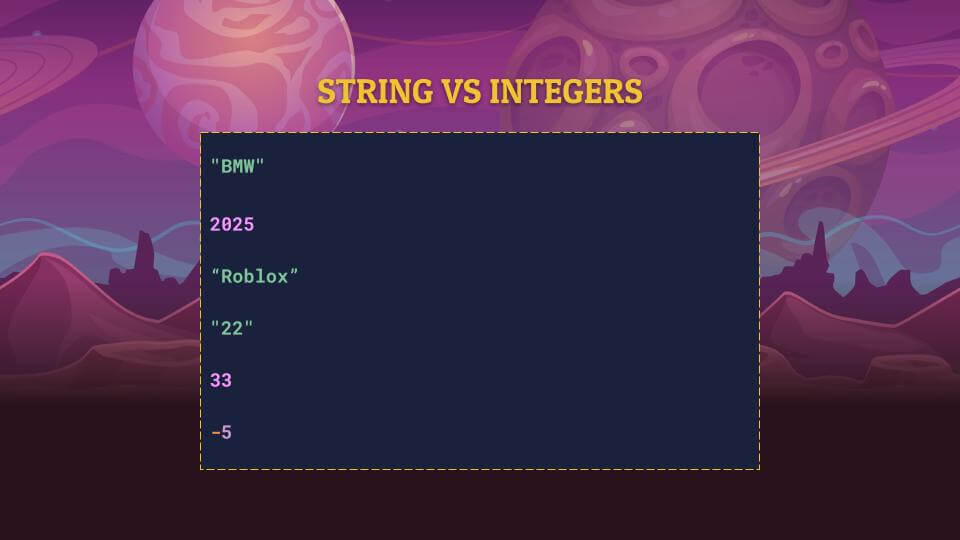
3. Variables
Variables are containers that hold a value or piece of data, like an integer or string.

You might remember these from math class where x isn’t a letter but actually represents a number.
In code, we could use a variable “age” to represent a number like 11. When you get older, the variable “age” stays the same, but the number it represents increases to 12. Using a name instead of a value makes Python code read like English.
Variables are powerful because they can be reused and changed easily.
Rules for Naming Python Variables
- Cannot start with a number
- Cannot contain spaces
- Cannot contain special characters except _ (underscores)
- Two variables cannot have the same name
In Python, you can assign a value to a variable using the equal sign:
Activity – Create the following variables in Python
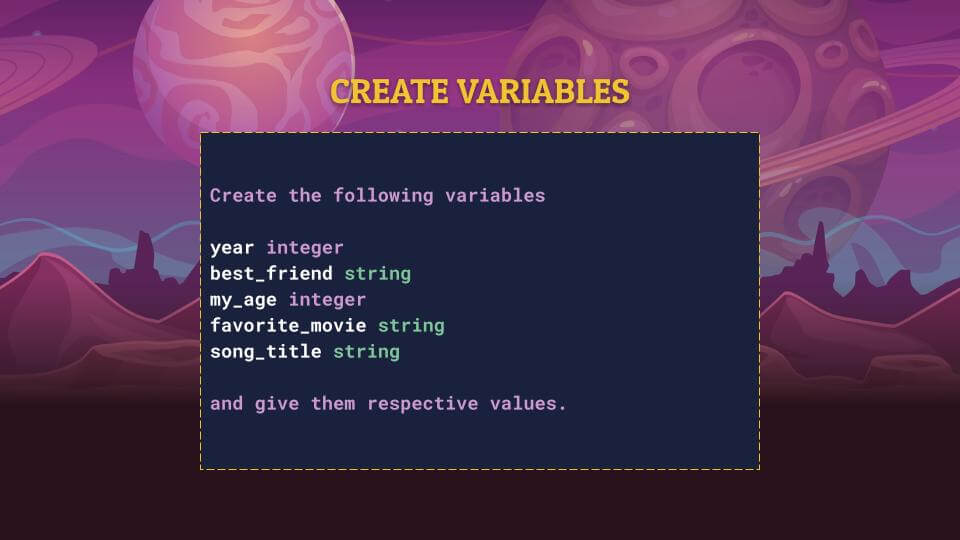
4. Functions
A function is a block of code that performs an action when it is called. They are usually a verb or a short phrase that have () at the end.

You can add arguments inside the parenthesis to pass data, or parameters, into a function. A function can return data as a result.

For example, you might have a function called addNumbers() and its job is to add two numbers. Whenever you need to add two numbers, you can call this function.
Code is often divided into many functions that perform different operations. Using functions allows programmers to be more efficient and avoid repeating the same logic or code.
To create a function you will first define it using def, followed by the name of the function and some parentheses.
Then, add the code inside it, indented by 4 spaces. You can run this function by writing just the function name followed by parentheses.
Rules for Naming Python Functions:
- Start with a letter or an underscore: _.
- They can have numbers.
- They can be any length
- They can’t be the same as a Python keyword.
Activity – Define and call a Python function.
5. Lists
In real life, we often make lists to group things together. For example, a to-do list or a grocery list.
In Python, lists are very similar. A list is an ordered collection of data.
Each element or value inside of a list is called an item. Lists are mutable meaning that the values in the list can change.
You define a list using [] and separate each item with a comma.

To obtain a value from your list, you must select the index for that list item, which always starts at 0.
In this list of foods, the first item “tacos” has an index 0. The next item, “pizza”, has an index of 1. The final item, “nachos”, has an index of 2.
To get “pizza”, we need to access the item in the list foods with an index of 1.
Activity – Create a Python list and access list data.
View solution 1 and solution 2.
6. Loops
A loop is a block of code that runs over and over while a certain condition is met.
Loops help programmers save time, so they don’t have to write the same code over and over. It also helps prevent mistakes and pesky bugs in our code.
Here’s an example, both of these give us the same output:
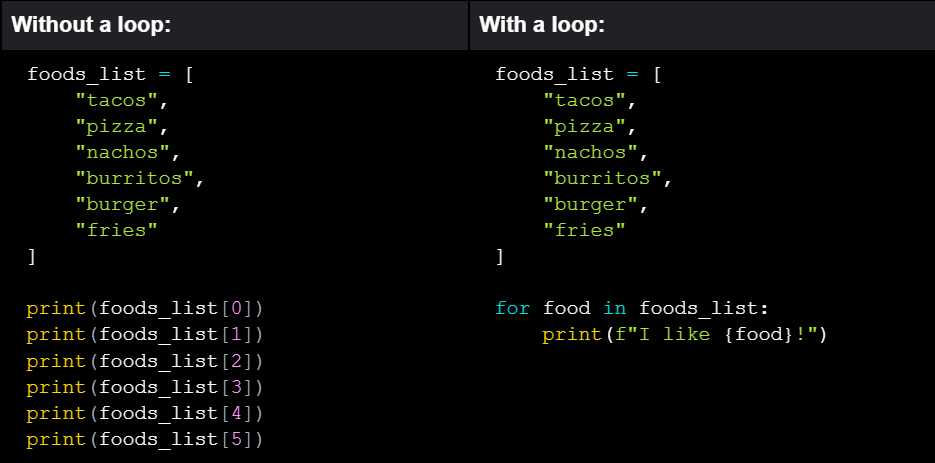
The loop prints all items in the list with only 2 lines of code, compared to 6 without it. Now, imagine if the list had 100 items, how many lines of code would you have to write without a loop? At least 100!
In Python, there are two types of loops: for loops and while loops.
A for loop repeats a series of commands over a sequence of data, like a list, a tuple, a dictionary, a set, or a string.
A while loop repeats a series of commands as long as certain conditions are true.
Activity – Print every number from 0 to 6 using a loop.
View solution 1 and solution 2.
7. Modules
Python modules are code libraries that contain sets of code you can include in your application.
Modules allow coders to reuse their code, avoid duplicate code, organize code, and improve the readability of their code.
You can use Python’s in-built modules or write your own custom modules.
In-built Modules
Python comes with a number of in-built modules that can help you perform a variety of tasks.
To access a module in your code, import it at the top of your file.
For example, you can import the math module to use the sqrt() function that exists there. This function calculates the square root of any number.
Instead of creating your own function for certain calculations, the math module provides a list of in-built functions to use.
See the full list of Python modules.
Custom Modules
You can also define your own functions, classes, and variables that can be used in one or many Python programs.
Custom modules help cut down large parts of a program into smaller, more manageable, and organized files. They are the .py files written in Python.
Write A Custom Module
Save this code in a file called newmodule.py

You’ve created your own module.
Use Your Custom Module
Now you can use that module by importing it in your Python program using the file name.

8. Conditional Statements
Conditional statements tell your program what to do depending on whether a condition is met or not. They’re also known as “if-else” statements.
For example, let’s say a neighbor greets you with hi. If they say hi, you would respond hello. However, if they say any other greeting, you will instead respond bye.
In code, we’d write an if-else statement like this:

If the greeting changes, your response will also change.
Conditional statements provide a way to make decisions in your program and execute different code based on those decisions.
Conditional statements always start with an “if” statement. An “if” statement is written by using the if keyword. It asks a true/false question and runs a code block based on the result.
To add an additional condition, use elif.
For any statements that do not meet the if and elif conditions, use else.
This code shows an example of an elif statement:

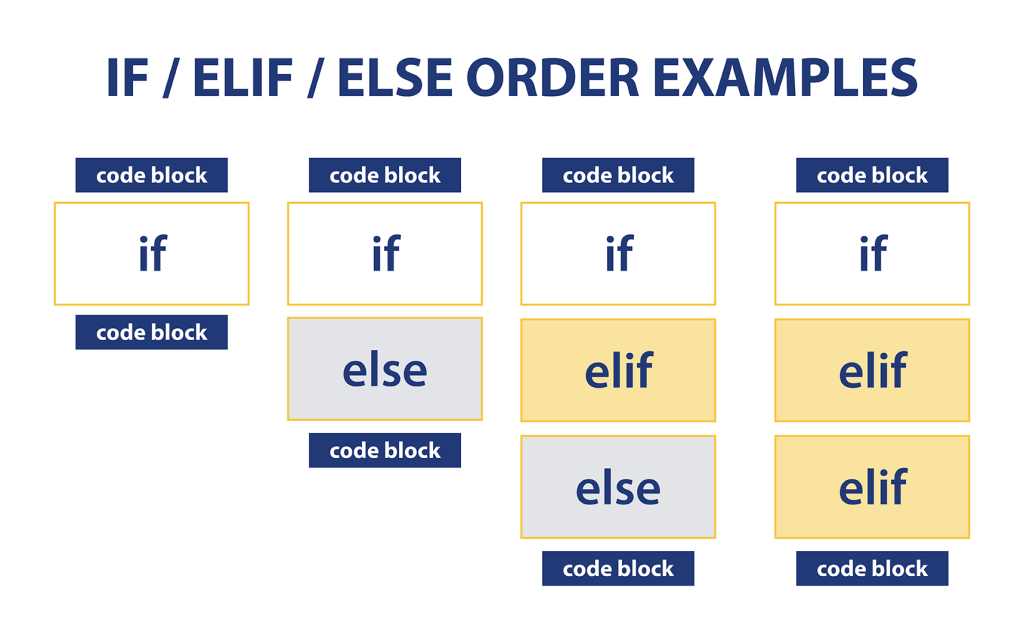
9. Operators
Operators are symbols used to perform operations on variables and values.
For example, arithmetic operators are used with numbers to add, subtract, multiply, and more. Here we are using the + (addition operator) and * (multiplication operator) to calculate an equation.

Python operators are categorized in the following groups:
- Arithmetic operators: used to perform common mathematical operations on numbers.
- Examples: +, -, *, /, %, **, //
- Assignment operators: used to assign values to variables.
- Examples: ==, +=, -=, *=, /=, %=, //=, **=, &=, |=, ^=, >>=, <<=
- Comparison operators: used to compare two values.
- Examples: ==, !=, >, <, >=, <=
- Logical operators: used to combine conditional statements.
- Examples: and, or, not
- Identity operators: used to compare if two objects are actually the same object with the same memory location.
- Examples: is, isnot
- Membership operators: used to test if a sequence is presented in an object
- Examples: in, not in
- Bitwise operators: Bitwise operators are used to compare (binary) numbers
- Examples: in, not in
Operators are used to manipulate data, perform mathematical calculations, compare values, and control the flow of your program.
10. User input
Many computer programs rely on communicating with an external user. Think of a search bar or form that prompts you, the user, to type or select some input.
To get information from the user in Python, we use the input() function.
The input() function displays a text prompt and input field to the user. Like this:
The user can respond and you also save the input to a variable so it can be accessed later on.
In this case, the user responded “Johnny” which was saved in the variable name.

Beginner Python Projects for Kids
Understanding Python concepts and practicing individual skills is a great place to start. The next step is to put it all together in a project where your child combines these skills into an actual program.
Project-based learning is one of the reasons the students in our coding classes are so successful. We highly encourage kids to think of a project they are excited about and slowly learn the skills to complete it.
Here are a few easy Python project ideas for kids and teens. Try putting your own spin on it to test your knowledge and creativity.
Dad Jokes App
Everyone loves a good dad joke, right? In this app, you’ll see how Python is can be used to pull data from an external API (Application Programming Interface) and use that data to make something goofy like a random dad joke generator. View project.
Strong Password Generator
When browsing the internet, you’re often asked to create a user account with a strong password to protect your account from hackers. In this app, you’ll learn how to create strong, secure passwords using Python! View project.
Quiz App
This project allows users to take a quiz to test their knowledge of different programming languages. The number of correct/incorrect answers are tracked and the user receives different messages depending on how well they did on the quiz. View project.
Pig Dice Game
“Pig” is an easy and fun dice game that anyone in the family can play. You only need one die in hand and know basic arithmetic to play the game. View project.
See more Python project ideas for kids.
Download 1-Week Python Lesson Plans
Kids ages 11-13 can start learning Python in a structured way. Download a FREE 1-week lesson plan with activities and slides. Enter your name and email to receive the free lesson plans in your inbox today.
Learn Python Programming with CodeWizardsHQ
Python coding is a unique skill that will benefit your child regardless of the path they choose. With dedication and practice, your child can learn Python programming!
If you want your child to get all the benefits of coding, enroll in CodeWizardsHQ’s live, online Python classes for kids.
The expert instructors give students the guidance and motivation to successfully learn to code. There are summer and year-round programs to fit every schedule and beyond-the-classroom support is included. It’s the most fun and effective way for kids to learn Python programming! View programs and enroll today.


